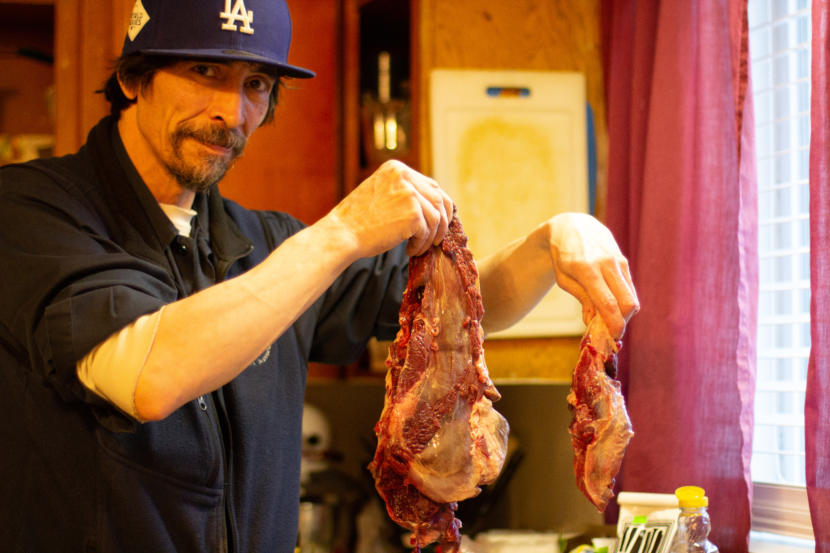
On the remote Bering Sea island of St. Paul, where groceries have to be barged or flown in, Serafima Edelen and her boyfriend still eat meat most nights. For the past several years, they’ve almost never had to buy it: The island and ocean provide them with an abundance of reindeer and fur seal.
“It was always nice knowing I didn’t have to go and buy any meat from the store — just because of how expensive everything is, living in the village,” said Edelen, 25. “I still refuse to move away. This is home. This is where I want to be.”
Plastic-wrapped chunks of meat fill the chest freezer in a back room of Edelen’s house. Her boyfriend shoots as many as 10 reindeer a year. And in the summer, you can find them both near St. Paul’s beaches, killing and processing fur seals in a subsistence harvest open to the island’s Alaska Native residents, who call themselves the Unangan people.
The seal harvest connects Edelen to her heritage, and to St. Paul. But it also makes a material difference to whether she can afford to live on the island, a 10-mile-wide volcanic speck more than 250 miles from the mainland.
At the island’s grocery store, it’s $6 for a pound of ground beef. A 12-ounce package of Oscar Mayer beef bologna costs $10.

But last year, health problems kept Edelen’s boyfriend from hunting. And even though fur seals are on or near the island year-round, federal regulations only allow a 47-day subsistence harvest in the summer. Edelen’s job and other obligations left her with little time to participate.
Eventually, she had to go to the store. It felt like crossing a line, she said: “To have to break down and realize: ‘I’m out of meat. I don’t have anything to cook.’”
St. Paul’s tribal government has been petitioning the federal government to relax the regulations governing the seal harvest for more than a decade. And now, the National Marine Fisheries Service is finishing a rewrite — one that would allow seals to be taken more than 11 months a year, and loosen restrictions on which animals can be killed.
Federal managers say the proposed revisions, released in August, will make a healthy, culturally relevant food source more accessible on the island, while granting the island’s tribal government more local control. A scientific analysis accompanying the rule change says it will have no significant effect on the fur seal population.
“There is no doubt that this is an important item, culturally and nutritionally, for the communities,” said Mike Williams, the fisheries service official overseeing the rule changes from Anchorage. “This is real food security.”
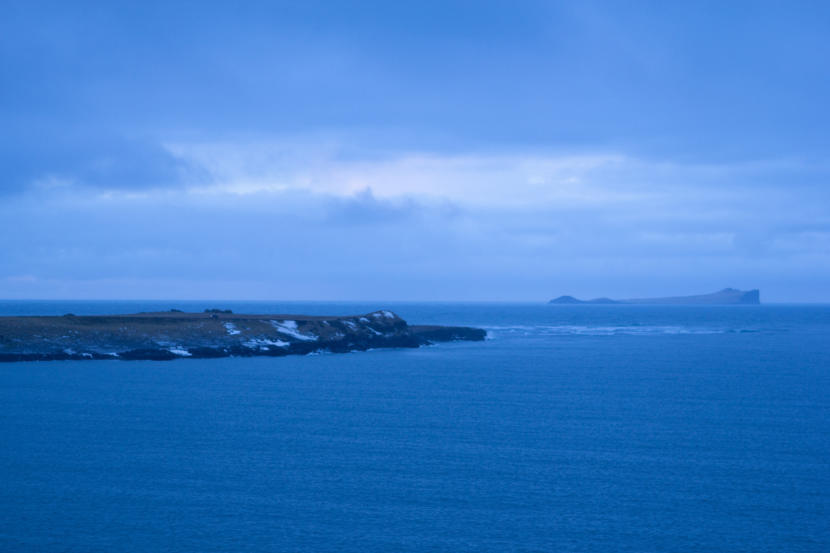
But the proposal faces opposition from the Humane Society of the United States, which has a decades-long history of activism in the Pribilofs.
The source of the organization’s concern: St. Paul’s fur seal population has been declining for years, and scientists don’t know why. Some 600,000 northern fur seals now return each summer to the Pribilofs, which include St. Paul and its sister island, St. George; that’s down from an estimated 2 million in the 1950s.
The federal government’s proposal leaves an annual 2,000-seal harvest limit in place — it’s designed to make it possible for St. Paul residents to get closer to the cap, since the current rules have had the effect of keeping harvests at far lower levels.
But it still doesn’t make sense for the government to loosen restrictions on the harvest until more is known about the population decline, said Sharon Young, the Humane Society’s marine issues field director.
“We don’t fully understand why there is a decline ongoing,” Young said in a phone interview from Massachusetts. “But there is a decline ongoing, and we’re very concerned that this is not the time to increase the number of animals that are being killed, or to use a way of killing them that is more indiscriminate.”
Some 600,000 northern fur seals, nearly half the global population, return each summer to the Pribilofs.
The U.S. government used to run a commercial harvest on the island, taking about 25,000 seals for their furs each year and sending profits to the treasury.
That harvest long depended on forced labor from St. Paul’s Unangan people — Alaska Natives originally relocated from the Aleutian Islands by Russian fur traders. After Alaska was sold, the U.S. government, for decades, compensated workers with little more than food and housing.
While the commercial harvest ended in the 1980s, the government left behind a legacy of tight regulation of the subsistence harvest — which has effectively limited it to no more than 400 seals a year for the past decade.
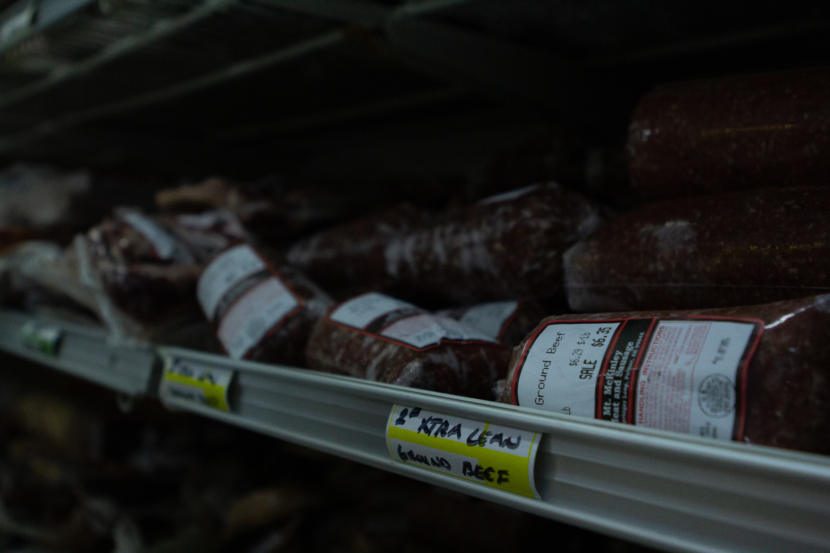
Many of St. Paul’s 500 residents don’t have time to participate because the harvest is limited to seven weeks in mid-summer — when they’re working as commercial halibut fishermen, earning cash to spend on groceries in winter.
The tender meat from the fur seal pups, known as laaqudan, is a favorite of Unangan people on St. Paul. But under the current federal regulations, the pups are off-limits year-round.
Some St. Paul residents still risk criminal penalties by harvesting them illegally, which in the past has drawn federal enforcement agents to the island. Under the proposed revisions, harvesting pups would be allowed.
Tribal leaders leaders say it doesn’t make sense for the seal harvest to be controlled by federal managers in Anchorage and Washington, D.C., when Unangan people live on the island and have a long history of working with the animals. The tribe has its own ecosystem conservation office that does subsistence research and runs the harvest in accordance with federal rules, under a co-management agreement with the fisheries service.
Sitting in the cab of his pickup truck on a dirt pullout overlooking the Bering Sea, Amos Philemonoff, the tribal president, fumed at the government’s restrictions, and the slow process of changing them.
“The harvest of fur seals is ingrained in us out here. It’s a part of who we are,” Philemonoff said, as a sea lion swam by in the ocean below. “To be severely restricted in expressing who we are is just a darn shame. We want nothing more than to live off the land, live off the sea. But unfortunately, we’re regulated out of that.”
‘A sacrifice a lot of guys can’t make’
When the Pribilofs were first occupied by the Russians, explorers described St. Paul’s beaches as so covered with marine mammals that they looked golden from the sea. They could hear the sound of the seals through the fog.
The Pribilofs were uninhabited until Russian colonists were first drawn there in the late 1700s. But Unangan oral traditions hold that they had discovered the islands long before, and used them as hunting grounds.
Before colonizing the Pribilofs, the Russians swept down the Aleutian Island chain in search of furs to sell to Asian markets. They found the Pribilofs while searching for seals to keep supplying those markets, after their harvest of Aleutian sea otters reduced the population to near-extinction.
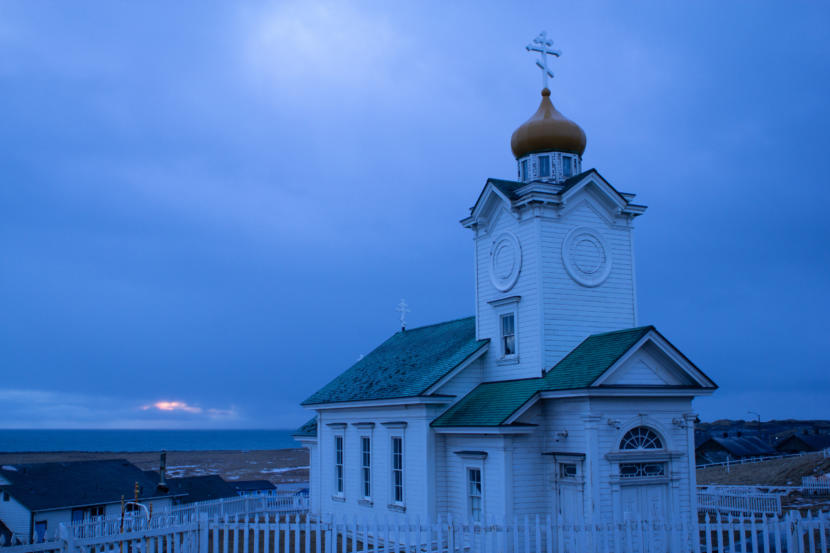
The ensuing commercial seal harvest in the Pribilofs lasted 200 years and depended on the Unangan people, who were forcibly resettled on the islands and conducted the harvest under Russian, then American management. The relationship between the managers and the Unangan people evolved over time, but through the start of World War II, the power dynamics were stark. One government agent, in a 1916 report, wrote that St. Paul’s residents were “living in actual slavery,” under the “immediate control and direction of the United States government.”
Unangan workers were paid largely in goods and services, not cash. The government controlled the distribution of food; only heads of household could pick up groceries at the store. Federal officials tried to pressure Pribilof men out of marrying women from the Aleutian Islands. Visits to the islands were restricted through the 1960s.
The commercial harvest continued through 1984, with about 25,000 seals taken on St. Paul each year. It ended when the U.S. Senate, under pressure from animal welfare groups, failed to renew an international treaty that governed the harvest.
At the time, seal meat was a staple of the Unangan people’s diet: Each St. Paul household ate about 13 pounds a week, according to a 1981 estimate. But when the federal government authorized Pribilofs residents to continue taking seals for subsistence, the regulations largely modeled the harvest on the commercial one, without accommodations for Unangan culture or the Pribilofs’ transition to a cash economy driven by commercial fishing.
Today, the St. Paul subsistence harvest looks much the same as it did 30 years ago. Tribal members meet in the mornings, then drive out to a spot above one of the rookeries where seals have hauled themselves out of the ocean.
Several men will sneak up on a group of seals, cutting off their path to the water, then herd the animals into the uplands — slowly, to keep them from overheating, which taints the meat. The seals are stunned with a long, wooden club, then killed with a cut to the heart and skinned. Participants can take meat home to process and freeze themselves, or deliver it to elders, friends and family.
The basic framework of the system works, according to tribal members. But the strict federal regulations surrounding present several unneeded obstacles, they argue.
Timing is a central problem.
On St. Paul, the subsistence season is only open between June 23 and Aug. 8, posing a dilemma for the island’s many commercial fishermen. Halibut fishing is one of the best cash-paying jobs available on St. Paul, but the peak season comes during the summer. And a single day off the water can cost a boat as much as $30,000, said Philemonoff, the tribal president and a commercial fisherman.
Philemoneff describes fishing as his means of paying for the expensive groceries that replace subsistence foods when they’re off-limits. If it’s the middle of winter and you need cash to buy food at the store, you can’t get it by fishing then, he said — the season is closed. That leaves the summer.
“So, the seal harvest is a sacrifice that a lot of guys just can’t make,” he said. “I’ve got my wife — she goes out and gets us a few seals every year from the harvest. But I can’t expect her to get a dozen for me and my family to put away for the winter.”
Because the harvest is typically held Thursdays and Fridays, Edelen, who works in accounting for the tribe, said she has to take a full day off to participate. She can only take so much time away from her job during the summer, which is a busy time of year. And sometimes, she’s arrived at the tribal office only to have the harvest canceled because too few people show up.
Edelen values the tradition of the seal harvest, she said, and it’s frustrating that it’s scheduled for such a short window.
“I’m stuck. I’m needed at my desk. There’s no one to replace me. I can’t go,” she said. “It’s kind of hard to accept. But I have to keep the roof over my head.”
The tribe also wants more latitude in the harvest timing because of the potential for climate change to affect when seals return to the rookeries each summer. St. Paul residents are particular about the size of the seals they harvest, and they don’t always arrive at the same time of year.
“I’ve seen, after the deadline, up to 1,500 animals that are perfect size, just, bam, show up. And you’re like, ‘Man, where were those?’” said Robert Melovidov, a tribal council member who was foreman of the subsistence harvest last summer. “We have no control over when spring is going to start and when winter is going to start. And those play a very big role in when the animals are here.”
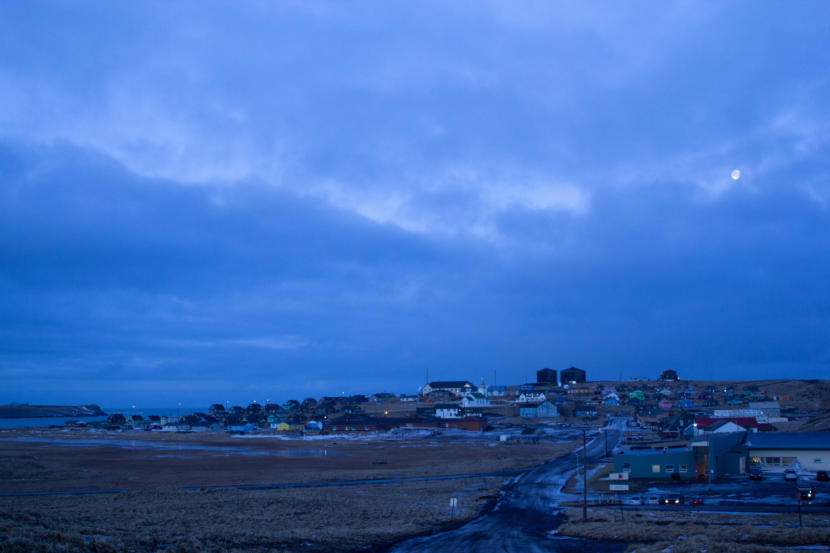
The new rules would also allow tribal members to hunt fur seals with guns between January and May. At that time of year, the animals aren’t hauled out on the rookeries, but individual seals can occasionally be spotted swimming just off shore. Tribal members say the swimming seals could be a source of fresh meat during the winter and spring — but the current regulations make it illegal to hunt the animals during those months.
Also banned year-round is harvesting the laaqudan, or seal pups. The Unangan people describe the taste of pup meat with longing, paired with deep frustration that they can only get it if they risk of being caught.
“If I hear somebody say there’s laquudan, I’m in line right away,” said Edelen. “And I will be that greedy person that grabs a little more than, maybe, I should.”
Elders, at a recent afternoon gathering for tea and cookies at St. Paul’s medical clinic, recalled threats and intimidation as part of the federal government’s enforcement efforts. Families would hide traces of the pups by burning their bones, said Zee Melovidov, 70.
“I remember my mom telling me: ‘Don’t throw ‘em out! Put ‘em in the stove,’” said Melovidov.
Both tribal leaders and federal officials said the ban on harvesting pups is a problem because it happens anyway, and unlike the organized and regulated summer harvest, government and tribal scientists get no data on the number of pups killed. If people are hunting hurriedly or while it’s dark to avoid detection, they’re are also more likely to lose track of an injured pup, or to accidentally kill a female — which has a far more negative effect on the overall population.
“A legal, monitored, reported harvest allows us to ensure that it’s sustainable, it’s meeting conservation goals and it’s being responsive to the fact that fur seals are a public resource,” said Williams, the fisheries service official. “Everything’s better in the light of day.”
‘A public trust resource’
Tribal leaders said the government did not actively police the pup harvesting ban until about a decade ago, when authorities discovered a number of uneaten carcasses left on a beach. That prompted a crackdown, with enforcement agents making trips to the island, which in turn pushed the tribe to work more closely with the federal government to change the regulations.
The tribe’s first request came in 2007. After several years of back and forth, the fisheries service formally opened the revision process.
After the release of a draft environmental review in 2017 and the proposed revisions last year, tribal leaders hoped there might be a legal pup harvest last fall. And after more than a decade of back and forth, Philemonoff, the tribal president, said he’s left with a sense that the federal government is not respecting the tribe’s sovereignty.
He also objects to one idea the fisheries service is considering as part of the revised regulations: hiring an independent contractor to make sure St. Paul residents are following the rules.
The Unangan people have been hunting fur seals for thousands of years, and it would be “insulting” to have the harvest monitored by someone who’s not from St. Paul, Philemonoff added.
“I think we’ve got pretty humane means of harvesting our subsistence resources here on the island,” he said. “And we don’t do it in a wasteful manner.”
Williams said he’s sensitive to the needs of the tribe and the importance of access to subsistence foods. While he works in Anchorage, he lived on St. Paul’s sister island, St. George, for three years, and he still travels to the Pribilofs regularly for research. At an interview last month, his forearm sported a scar that a fur seal pup bite inflicted last summer.
Williams has been working on the rule change since the process started in 2007. He said the he, too, is frustrated about how long it’s taken.
“I would have never predicted it would take 10 years to get through the process — to come to agreement on fundamental issues related to people on St. Paul wanting to eat,” he said.
But, Williams added, the federal government’s obligations are complicated by the seals’ precarious and protected status.
There were an estimated 2.1 million fur seals in the Pribilofs in the 1950s. Today, the population is one-fourth of that and designated as “depleted.” Federal scientists estimate that the number of fur seals born on St. Paul — home to the vast majority of the Alaska population — has been falling 4 percent a year for two decades.
There’s no scientific consensus on the cause of the decline. Researchers, and some St. Paul residents, have eyed industrial-scale fishing in the Bering Sea that targets a species called pollock — one of fur seals’ primary foods — but that link has not been definitively established.
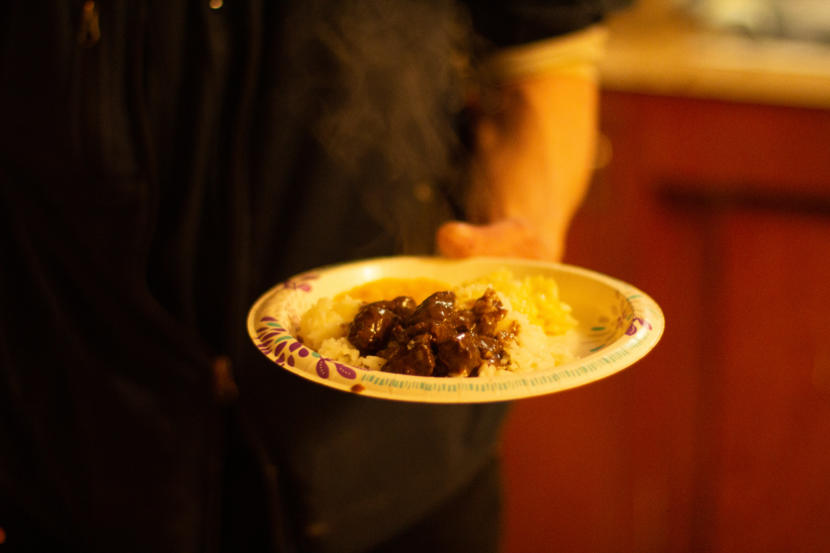
The decline, and the uncertainty about its cause, meant the fisheries service had to be especially careful in its drafting and justification of the rewritten harvest rules, Williams said.
The agency’s actions are being carefully scrutinized by the Humane Society, which is concerned about the fur seal population’s overall health, said Young, the organization’s marine issues field director.
The group’s involvement in the Pribilofs dates back more than 45 years, to when it sent an observer to document what it called the “brutality” of the commercial harvest.
Young said she hasn’t seen a “strong justification” for the proposal to change the subsistence regulations — though she acknowledged that she’s never been to St. Paul or engaged its tribal leaders in direct dialogue. Broadly, Young said, her organization’s Pribilofs advocacy is part of its mission to ensure that wildlife management is “humane and sustainable.” In its nine-page formal comment letter to the fisheries service, the group called the government’s proposal to deregulate the subsistence harvest “impermissibly risk-prone.”
“This is a public trust resource. All of the marine mammals of the United States are the property of all the citizens of the United States,” Young said. “The harbor seals here in Massachusetts are not simply the property of the citizens of Massachusetts, any more than the fur seals are the property of the folks in the Pribilofs on whose islands they breed.”
The Humane Society went to court in the 1990s in a failed effort to try to limit the harvest of the Pribilofs’ fur seals; Young said her organization won’t decide on its next steps until it sees the final version of the new rules.
Williams acknowledged that more seals will be killed if the proposed rule change is adopted. But the fisheries service, supported by an 11-page statistical analysis, said in its proposal that even harvesting all 2,000 seals allowed under the cap will not have “significant, negative population consequences,” whether those seals are juveniles or pups.
That’s largely because of the way the seals reproduce. The harvest is restricted to male seals, and because one male can breed with as many as 100 females in a single summer, fewer males are needed to sustain the overall population.
The male pups are even less important from a population standpoint, according to the fisheries service, since the pups already have a higher mortality rate: More than half are predicted to die before they turn two years old.
“We are confident in the biological consequences even if the community needs that full 2,000 animals for food security and subsistence. That is still safe for the population,” said Williams. He added: “The potential impact on the population is barely detectable.”
Williams said he hopes the proposed rule change can take effect in time for St. Paul to harvest pups before the end of 2019.
Residents are excited for year-round access to fresh meat, said Philemonoff, the tribe’s president — in part because it’s much healthier than the processed food at the store.
Philemonoff said he’s a “case in point.” He has diabetes, high blood pressure and high cholesterol, and rather than eating frozen food from the store, he said he’d like more fur seal. His favorite is when it’s cooked in a pot roast, with gravy, over rice or potatoes.
“If I got back to a totally traditional diet,” he said, “I probably wouldn’t have half the issues I have right now.”
